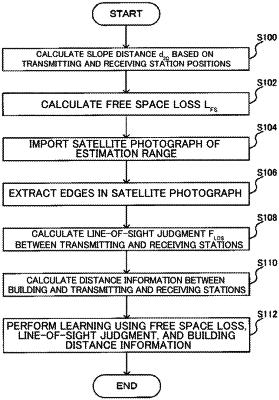| CPC H04W 16/18 (2013.01) [G06T 7/13 (2017.01); H04B 17/309 (2015.01); G06T 2207/10032 (2013.01); G06T 2207/20081 (2013.01); G06T 2207/30184 (2013.01)] | 4 Claims |

|
1. A propagation characteristic estimation device for estimating a propagation characteristic of radio waves between a transmitting station and a receiving station that perform wireless communication, the propagation characteristic estimation device comprising:
a processor; and
a storage medium having computer program instructions stored thereon, when executed by the processor, perform to:
based on input information from an external source, extract position information regarding the transmitting station and the receiving station and a frequency of radio waves transmitted by the transmitting station;
calculate a three-dimensional distance between the transmitting station and the receiving station and a free space loss of radio waves based on the position information and the frequency;
perform processing for, with use of a two-dimensional image of a region that includes the transmitting station and the receiving station, extracting an edge of a structure that reflects radio waves in the two-dimensional image;
generate input data for use in machine learning, based on the position information, the three-dimensional distance, the free space loss, and the edge; and
perform machine learning to estimate a propagation characteristic of radio waves between the transmitting station and the receiving station with use of the input data generated by the generation unit.
|